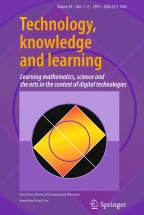Explore related subjects
Discover the latest articles, news and stories from top researchers in related subjects.REFERENCES
Balacheff, N. and Soury-Lavergne, Sophie (1996). Explication et préceptorat, à propos d'une étude de cas dans TéléCabri. In M. Joab M. (Ed.), Explication' 96 (pp. 343–356).Sophia Antipolis: INRIA.
Balacheff, N. and Sutherland, R. (1994). Epistemological domain of validity of microworlds: The case of Logo and Cabri-géomètre. In R. Lewis and P. Mendelsohn (Eds), Lessons from Learning (pp. 137–150). IFIP Conference TC3WG3.3, North Holland.
Booth, L. (1984). Algebra: Children's Strategies and Errors. Windsor: NFER-Nelson.
Brousseau, G. (1997). Theory of Didactical Situations in Mathematics. Dordrecht, The Netherlands: Kluwer Academic Publishers.
Bruner, J. (1983). Child's Talk: Learning to Use Language. Oxford: Oxford University Press.
Capponi, B. and Balacheff, N. (1989). Tableur et calcul algébrique. Educational Studies in Mathematics 20: 179–210.
Chevallard, Y. (1984). Le passage de l'arithmetique a l'algèbre dans l'enseignment des mathèmatiques au Collège. Petit Y: 51–95 (IREM de Grenoble).
Cobb, P. (1995). Cultural tools and mathematical learning: A case study. Journal for Research in Mathematics Education 26(4): 362–385.
Cobb, P., Yackel, E. and Wood, T. (1992). Interaction and learning in mathematics classroom situations. Educational Studies in Mathematics 23(99): 100–122.
Cobb, P. (1997). Learning from distributed theories of intelligence. In E. Pehkonen (Ed.), Proceedings of the 21st Conference of the International Group for the Psychology of Mathematics Education, Vol. 2 (pp. 169–176). Lahti, Finland: University of Helsinki.
Cockcroft, W. H. (1982). Mathematics Counts. Report on the Committee of Inquiry in Teaching of Mathematics London: HMSO.
Confrey, J. (1995). A theory of intellectual development. For the Learning of Mathematics 15(1): 38–48.
Dettori, G. and Lemut, E. (1998). From arithmetic to algebraic thinking using spreadsheets. In R. Sutherland, T. Rojano, A. Bell and R. Lins (Eds), Algebraic Processes and Structure. Dordrecht, The Netherlands: Kluwer Academic Publishers.
Dorfler, W. (1993). Computer use and views of the mind. In C. Keitel and K. Ruthven (Eds), Learning from Computers: Mathematics Education and Technology, NATO ASI 121 (pp. 2159–186). Berlin: Springer Verlag.
Edwards, D. and Mercer, N. (1987). Common Knowledge: The Development of Understanding in the Classroom.Methuen, U.K.
Feurzeig, W., Papert, S., Bloom, M., Grant, R. and Solomon, C. (1969). Programminglanguages as a conceptual framework for teaching mathematics. Final Report of the First Fifteen Months of the Logo Project. Cambridge, MA: Bolt, Beranelk and Newman.
Filloy, E. and Rojano, T. (1989). Solving equations: The transition from arithmetic to algebra. For the learning of Mathematics, 9.2. Canada.
Hoyles, C. and Sutherland, R. (1989). Logo Mathematics in the Classroom. London: Routledge.
Kilpatrick, J. and Davis, R. B. (1993). Computers and curriculum change in mathematics. In C. Keitel and K. Ruthven (Eds), Learning from Computers: Mathematics Education and Technology, NATO ASI 121 (pp. 203–221). Berlin: Springer Verlag.
Lesgold, A. (1993). Information technology and the future of education. In S. Lahoe and S. Derry (Eds), Computers as Cognitive Tools. Hillsdale: LEA.
Lins, R. (1998). The production of meaning for algebra: A perspective based on a theoretical model of semantic fields. In R. Sutherland, T. Rojano, A. Bell and R. Lins (Eds), Algebraic Processes and Structure. Dordrecht, The Netherlands: Kluwer Academic Publishers. f
Nemirovsky R. (1997). A functional approach to algebra: Two issues that emerge. In N. Bednarz, C. Kieran and L. Lee (Eds), Approaches to Algebra: Perspectives for Research and Teaching. Dordrecht, The Netherlands: Kluwer Academic Publishers.
Noss, R. and Hoyles, C. (1996). Windows on Mathematical Meanings: Learning Culture and Computers. Dordrecht, The Netherlands: Kluwer Academic Publishers.
Ohlsson, S. (1991). System hacking meets learning theory: reflection on the goals and standards of research in artificial intelligence and education. Journal of Artificial Intelligence in Education 2(3): 5–18.
Rojano, T. and Sutherland, R. (1993). Towards an algebraic approach: The role of spreadsheets. Proceedings of the 17th International Conference for the Psychology of Mathematics Education (pp. 189–196).Japan.
SMP 11-16 (1984). Algebra. Cambridge: Cambridge University Press.
Sutherland, R. (1993). Connecting theory and practice: Results from the teaching of Logo. Educational Studies in Mathematics 24: 1–19.
Sutherland, R., Howell, D. and Wolf, A. (1996). A Spreadsheet Approach to Maths for GNVQ Engineering. London: Hodder Headline.
Sutherland, R. and Rojano, T. (1993). A spreadsheet approach to solving algebra problems. Journal of Mathematical Behaviour 12(4): 351–383.
The Royal Society/JMC Report (1997). Teaching and Learning Algebra Pre-19. London: The Royal Society.
Von Glaserfeld, E. (Ed) (1991). Radical Constructivism in Mathematics Education. Dordrecht, The Netherlands: Kluwer Academic Publishers.
Vygotsky, L. S. (1978). Mind in Society: The Development of Higher Psychological Processes. Cambridge, MA: Harvard University Press.
Walkerdine, V. (1988). TheMastery of Reason: Cognition Development and the Production of Rationality. London: Routledge.
Wertsch, J. and Stone, A. (1985). The Concept of internalisation in Vygotsky's account of the genesis of higher mental functions. In Wertsch (Ed.), Culture, Communication and Cognition, Vygotskian Perspectives. Cambridge: CUP.
Wood, D., Bruner, J. S. and Ross, G. (1976). The role of tutoring in problem solving. The Journal of Child Psychology and Psychiatry 17: 89–100.
Author information
Authors and Affiliations
Rights and permissions
About this article
Cite this article
Sutherland, R., Balacheff, N. Didactical Complexity of Computational Environments for the Learning of Mathematics. International Journal of Computers for Mathematical Learning 4, 1–26 (1999). https://doi.org/10.1023/A:1009882419704
Issue Date:
DOI: https://doi.org/10.1023/A:1009882419704
